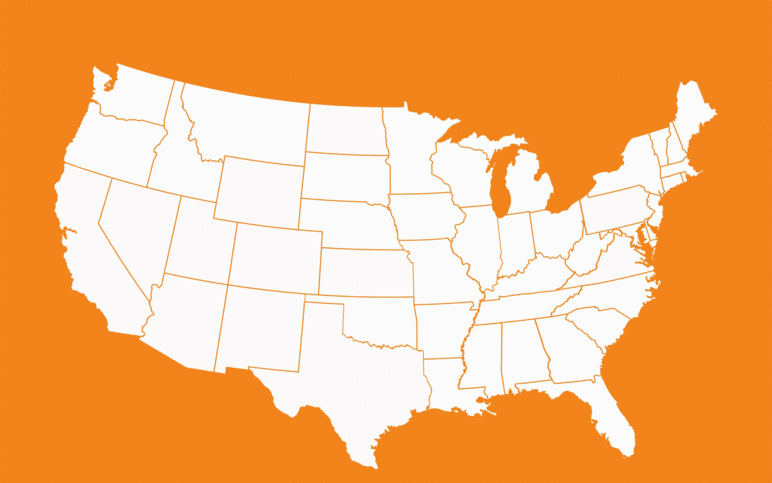Tobacco use in these 12 U.S. states is on par with a number of developing countries. Why?
Tobacco use in a group of 12 states stretching from the upper Midwest to the South looks more like some of the most tobacco-affected countries in the world than the rest of the U.S.
In fact, this collection of 12 contiguous states — Alabama, Arkansas, Indiana, Kentucky, Louisiana, Michigan, Mississippi, Missouri, Ohio, Oklahoma, Tennessee and West Virginia — would rank in the top five of the Bloomberg Initiative’s 10 countries with the highest rates of tobacco use.
Twenty-two percent of adults smoke in “Tobacco Nation” — a term for these 12 states coined in a recent Truth Initiative® report on the topic — compared to 15 percent of adults in the rest of the U.S. The area’s 12- to 17-year-olds smoke at a rate of 12 percent compared to 9 percent for the other 38 states. That ranks Tobacco Nation fourth for youth smoking in comparison to the Bloomberg Initiative’s 10 countries with the highest rates of tobacco use, higher than the Philippines, Brazil, Pakistan, China, India, Vietnam and Bangladesh. Tobacco Nation has the fifth-highest adult smoking rate, behind only Indonesia, Ukraine, China and the Philippines.

Why has Tobacco Nation been left so far behind the rest of the country? Three key areas play a big role.
Policy
More than 66 million people live in Tobacco Nation, roughly 20 percent of the U.S. population. Compared with the rest of the country overall, states within Tobacco Nation have fewer policies in place that have been proven to reduce tobacco use.
For example:
- The average tobacco tax and price of a pack of cigarettes is much lower in Tobacco Nation than in the rest of the country. The average tobacco tax is 98 cents in Tobacco Nation, compared to $1.89 in the rest of the U.S. Tobacco Nation’s average price of a cigarette pack is $5.48, which is 19 percent cheaper than in the rest of the country, where an average pack costs $6.72.
- Only two states in Tobacco Nation — Michigan and Ohio — have laws banning smoking in workplaces, restaurants and bars. Many of the other 38 states — 23 — have comprehensive smoke-free policies in place, which cover 65 percent of their population.
- Except for 23 localities found in Arkansas, Ohio, Missouri, Michigan and Mississippi, no states, or other areas within Tobacco Nation, have laws that set the minimum age of purchasing tobacco to 21. Across the rest of the country, five states and over 200 localities have passed these laws.
Industry Influence
The tobacco industry expends huge amounts of resources to market its products and to lobby against tobacco control policies.
Each year from 2000 to 2014, tobacco companies spent more than $8 billion marketing and promoting products in the U.S. In each of the 12 Tobacco Nation states, the Campaign for Tobacco-Free Kids estimates that the tobacco industry has spent more than $100 million on marketing in recent years.
Lobbying expenditures for Big Tobacco also reach into the millions. So far in 2017, tobacco companies have spent over $16 million on lobbying and gave more than $2.5 million to congressional candidates in the 2016 election cycle, according to the Center for Responsive Politics.
The tobacco industry also works to block proven tobacco control strategies, such as price increases and smoke-free spaces. For example, the tobacco industry has funded many campaigns to oppose tobacco tax increases, including a 2016 campaign in Indiana which helped defeat an infrastructure funding bill that included an increase in the cigarette tax.
Culture
A culture of tobacco use can exist in areas with higher smoking rates. “You’re really looking at a culture where this is acceptable, and we have to figure out ways to make health be the acceptable choice,” said Alana D. Knudson, principal research scientist and co-director of the University of Chicago’s Walsh Center for Rural Health Analysis, at a Truth Initiative panel discussion on Tobacco Nation.
Public education campaigns can play a big part in de-normalizing tobacco use. For example, truth® — the country’s most successful and longest-running youth tobacco prevention program — delivers the facts about the health effects and social consequences of tobacco use and the marketing tactics of the tobacco industry so that young people can make informed decisions and influence others to do the same.
To learn more about Tobacco Nation, read the Truth Initiative report “Tobacco Nation: The Deadly State of Smoking Disparity in the U.S.”
More in smoking by region
Want support quitting? Join EX Program
By clicking JOIN, you agree to the Terms, Text Message Terms and Privacy Policy.
Msg&Data rates may apply; msgs are automated.



